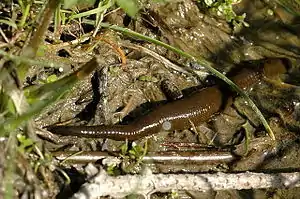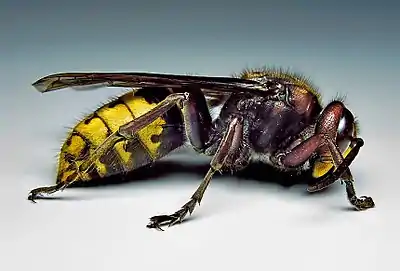< Korean < Words










| |
말+
- Roman: mal+
- Topic
- 말과 함께 보기.
- Relating to the horse.
말

A horse
- Roman: mal
- Noun
- Compounds
- 말- (mal-, prefix meaning "large")
- Comparatives
|
사마
- Roman: sama
- Hanja: 司馬
- Noun
- Comparatives
|
- See also
- 말 (mal, "horse")
말-
- Roman: mal-
- Prefix
- ‘큰’의 뜻을 더하는 접두사. [5] [6]
- horse- (Usage notes: The noun can be used attributively in compounds and phrases to add the sense of large and/or coarse.) [7]
말개미

Formica rufa, also known as the red wood ant, southern wood ant, or horse ant, is ...

A caterpillar being bitten by F. rufa
- Roman: mal-gaemi
- Noun [8]
- Synonyms
- Relatives
- 개미 (gaemi, "ant")
- Comparatives
|
- See also
말거머리

A horse leech on Wikipedia
- Roman: mal-geomeori
- Noun [18]
- Relatives
- 거머리 (geomeori, "leech")
- Comparatives
|
| ||||
- See also
말벌

A hornet or *horse-bee
- Roman: mal-beol
- Noun [26]
- Relatives
- 벌 (beol, "bee")
- Comparatives
|
왕게
- Roman: wang-gae
- Hanja: 王게
- Noun [32]
- Relatives
- 게 (ge, "crab")
- Comparatives
- See also
- 말개미 (mal-gaemi, "horse ant")
마름

Water caltrop, aka. water chestnut (Trapa natans cf. Trapa japonica) fruits

A 16th-century caltrop

Corm of (Chinese) water chestnut (Eleocharis dulcis)
- Roman: mareum
- Older: < 마람 (maram) < 말암 (mal-am) < 말왐 (mal-wam) < 말ㅸㅏㅁ (mal-vam[36]) < 말밤 (mal-bam) [37]
- Noun
- 마름과에 속한 한해살이풀. 연못이나 늪에서 자란다. 뿌리는 진흙 속에 박고 줄기는 물위에까지 가늘고 길게 뻗는다. 잎은 줄기 꼭대기에 뭉쳐나고 삼각형이며, 잎자루에 공기가 들어 있는 부낭(浮囊)이 있어서 물위에 뜬다. 여름에 흰 꽃이 피며 마름모꼴의 열매가 열리는데 이것을 까서 먹는다. 한국, 일본, 중국 등지에 분포한다. 학명은 Trapa japonica이다. [38] [39]
- water caltrop, aka. water chestnut [40]
- Compounds
- Relatives
- Comparatives
|
- Alias
The water caltrop is any of three extant species of the genus Trapa: Trapa natans, Trapa bicornis and the endangered Trapa rossica. It is also known as water chestnut, buffalo nut, bat nut, devil pod, ling nut, lin kok, ling jow, ling kio nut, mustache nut or singhada.
[...]
The generic name Trapa is derived from the Latin word for "thistle", calcitrappa, as also is another common name for the water caltrop.
The Chinese name is língjiǎo (菱角), líng meaning "caltrop" and jiǎo meaning "horn". This is often rendered as ling nut by English-speakers.- See also
- 남가새 (namgasae, "Tribulus terrestris")
말밤
- Roman: mal-bam
- Hanja: 末栗 [44]
- Noun
- ‘마름’의 방언(강원, 경상, 충북). [45] [46]
- (etymon, now dialect) water caltrop, water chestnut
- Synonyms
- See also
- 말밤* (mal-bam, toward "horse chestnut")
말밤*

The horse-chestnut fruits, aka. conkers
- Roman: mal-bam*
- Alias: *말밤 (assumed of sense)
- Hanja: 末栗 (literally "coarse chestnut" hence "horse chestnut" in use)
- Noun
- 학명 Aesculus hippocastanum 의 한 차입번역어. [48]
- Synonyms
- 마로니에 (maronie, "horse chestnut") -- the loanword from French. [50]
- 서양칠엽수 (seoyang-chil-yeobsu, "horse chestnut") [51]
- 가시칠엽수 (gasi-chil-yeobsu) [52]
- 일본칠엽수 (ilbon-chil-yeovsu) Aesculus turbinata [53]
- Relatives
- 말밤 (mal-bam, "water caltrop, water chestnut") -- the etymon, now dialect.
- 마름 (mareum, "water caltrop, water chestnut") -- the corrupted, now canonized.
- 물밤 (mul-bam, "water caltrop, water chestnut") -- the dialect, conforming to "water chestnut."
- Comparatives
|
|
- References
- Lack, H. Walter. (2001). "The Discovery and Rediscovery of the Horse Chestnut." Arnoldia 61/4, pp. 15-19.
마로니에

A horse chestnut tree
- Roman: maronie
- From; French marronnier [64]
- Noun
- 칠엽수과의 낙엽 교목. 줄기는 높이가 20~25미터이고 둘레가 6미터에 이르는 것도 있다. 잎은 마주나고 장상 복엽으로 길이가 20cm 정도인데 끝이 뾰족하고 톱니가 있다. 5~6월에 흰 바탕에 붉은 무늬가 있는 종 모양의 꽃이 원추(圓錐) 화서로 핀다. 마롱이라고 하는 열매는 삭과(蒴果)로 가시가 있고 단맛이 많은 전분질이어서 식용한다. 유럽 남부가 원산지이며 세계 4대 가로수, 정원수로 세계 각지에서 재배한다. ≒서양칠엽수. (Aesculus hippocastanum) [65] [66]
- horse chestnut tree
- Synonyms
- 서양칠엽수 (seoyang-chil-yeobsu)
- 가시칠엽수 (gasi-chil-yeobsu) [67]
- 일본칠엽수 (ilbon-chil-yeovsu) Aesculus turbinata
- Hypernyms
- Relatives
- See also
- 말밤 (末栗, mal-bam, "water chestnut")
- 말밤* (末栗, mal-bam*, "horse chestnut")
- https://namu.wiki/w/마로니에
Footnotes
- ↑ https://ko.dict.naver.com/#/search?query=말
- ↑ https://en.wiktionary.org/wiki/말
- ↑ 뉴에이스 국어사전
- ↑ (máršal)
- ↑ https://ko.dict.naver.com/#/search?query=말-
- ↑ https://en.wiktionary.org/wiki/말#Etymology_2
- ↑ https://www.websters1913.com/words/Horse
- ↑ 말 (mal, "horse") + 개미 (gaemi, "ant")
- ↑ https://ko.dict.naver.com/#/search?query=말개미
- ↑ https://en.wiktionary.org/wiki/말개미
- ↑ 그러면, 거꾸로, 왕개미는 일상적인 ‘말개미’를 고답적으로 또는 학술적으로 이르는 말인가?
- ↑ However, you may not like its Korean calque or loan translation 홍개미 that must be 말개미 in Korean context!
- ↑ 개밋과의 곤충. 몸의 길이는 7~13mm이며, 검은색 또는 갈색이고 금빛 털이 빽빽하게 나 있다. 일개미의 머리는 타원형인데 수컷의 머리는 둥글다. 한국, 일본 등지에 분포한다.
- ↑ 개밋과의 곤충. 일개미의 몸의 길이는 8mm 정도이며 붉은 갈색이고, 배는 어두운 갈색이다. 암컷은 머리와 가슴이 검은 갈색이고 꽁지는 붉은 갈색이다. 한국, 유럽, 일본, 중국 등지에 분포한다.
- ↑ This looks like a loan translation of Formica rufa.
- ↑ Maybe it began with "horse ant"(馬蟻) and ended with simply "ant"(螞蟻), as 馬("horse") corrupted into 螞("insect").
- ↑ "Horse ant (Zoöl.), a large ant (Formica rufa); -- called also horse emmet."
- ↑ 말 (mal, "horse") + 거머리 (geomeori, "leech")
- ↑ https://ko.dict.naver.com/#/search?query=말거머리
- ↑ https://en.wiktionary.org/wiki/말거머리
- ↑
- ↑ Created by User:KYPark, 22 February 2013
- ↑ All the original {{t}} templates were made {{t-}} but for Finnish {{t+}} by Rukhabot, 2 April 2013.
- ↑ Added by User: Atitarev, 26 February 2013
- ↑ Added by User:Wyang, 22 February 2013
- ↑ 말 (mal, "horse") + 벌 (beol, "bee")
- ↑ https://ko.dict.naver.com/#/search?query=말벌
- ↑ https://en.wiktionary.org/wiki/말벌
- ↑ Or *horse-bee, as it is much bigger than common bees.
- ↑ cf. Pferdeameise ("horse ant"), Pferdebremse ("horse fly"), Pferdeegel ("horse leech"), Pferdefliege ("horse fly").
- ↑ The most common is the red king crab, also called Kamchatka crab or Alaskan king crab, as native to the far northern Pacific Ocean. It can reach a leg span of 1.8 m (5.9 ft).
- ↑ 왕 (王, wang, "king") + 게 (ge, "crab")
- ↑ https://ko.dict.naver.com/#/search?query=왕게
- ↑ https://en.wiktionary.org/wiki/왕게
- ↑ In https://www.websters1913.com/words/Horse, it reads: "Horse crab (Zoöl.), the Limulus; -- called also horsefoot, horsehoe crab, and king crab." Either king crab or horse crab is so big, hence the name.
- ↑ The soft labial ㅸ, hence /v/. This descendant meant not only "water caltrop" but also "caltrop," according to 교학고어사전, p.538, equating to 마름쇠.
- ↑ The oldest 말밤 is still used widely as a dialect, together with 물밤 (mul-bam).
- ↑ https://ko.dict.naver.com/#/search?query=마름
- ↑ https://en.wiktionary.org/wiki/마름
- ↑ Either enjoys few Western #Translations.
- ↑ The Hanja translations include 능철(菱鐵, lit. "(water) caltrop iron"), 철릉(鐵菱, lit. "iron caltrop"), etc.
- ↑ A folk Sino-Korean name (鄕名, 향명, hyang-meong)
- ↑ Hence lit. the homonym "horse chestnut," as it were!
- ↑ Literally "coarse chestnut"
- ↑ https://ko.dict.naver.com/#/search?query=말밤
- ↑ https://ko.dict.naver.com/#/search?query=마름
- ↑ This canonic term is a corruption of the original 말밤 (末栗, "coarse chestnut"), which may be applicable to the horse chestnut as well, though not yet attested. Recall that the prefix horse means not only "big" but also "coarse" respectively relating to Korean homonyms 말(馬, "horse; big") and 말(末, "last; coarse").
- ↑ Unauthorized, hence the asterisk.
- ↑ https://en.wiktionary.org/wiki/horse_chestnut
- ↑ This is implausibly imported, perhaps under the Japanese watering influence; instead, it would be plausible to reuse the native 말밤 which is not used canonically. Also noteworthy is the resemblance of marron to 마름 (mareum) stemming from 말밤.
- ↑ A mundane Sino-Korean harangue, contrasting to the Japanese as yin-yang, either-or.
- ↑ 열매는 밤과 닮았지만, 사포닌과 글루코사이드가 들어있는 등 약한 독성을 띄고 있어서 먹을 수 없다.
- ↑ Framing around Japan? By whom?
- ↑ So called perhaps because of misbelief that the origin is India.
- ↑ Literally, "sea or water chestnut"
- ↑ Literally, "horse chestnut"
- ↑ 1. chestnut, 2. horse chestnut.
- ↑ French marron confuses many senses, including water, horse, coarse, chestnut, horse or chestnut color, etc.
- ↑ Literally, "white chestnut," perhaps because of the horse-chestnut's whitish flower
- ↑ Literally, "common chestnut." Which sense of the marronier at all?
- ↑ Literally, "horse chestnut"
- ↑ Literally, "false chestnut"
- ↑ "chestnut"
- ↑
- chestnut tree
- horse-chestnut tree
- ↑ https://ko.dict.naver.com/#/search?query=마로니에
≒서양칠엽수. (Aesculus hippocastanum)
(학명)Aesculus hippocastanum - ↑ '식용한다'?
- ↑ 열매는 밤과 닮았지만, 사포닌과 글루코사이드가 들어있는 등 약한 독성을 띄고 있어서 먹을 수 없다.
- ↑
- chestnut
- horse-chestnut
- ↑ 마로니에의 열매. 구워 먹는 밤의 하나로 지름 6cm 정도의 공 모양이며, 가시 모양의 돌기가 있는데 안에 한두 개의 씨가 들어 있다.
This article is issued from Wikiversity. The text is licensed under Creative Commons - Attribution - Sharealike. Additional terms may apply for the media files.

